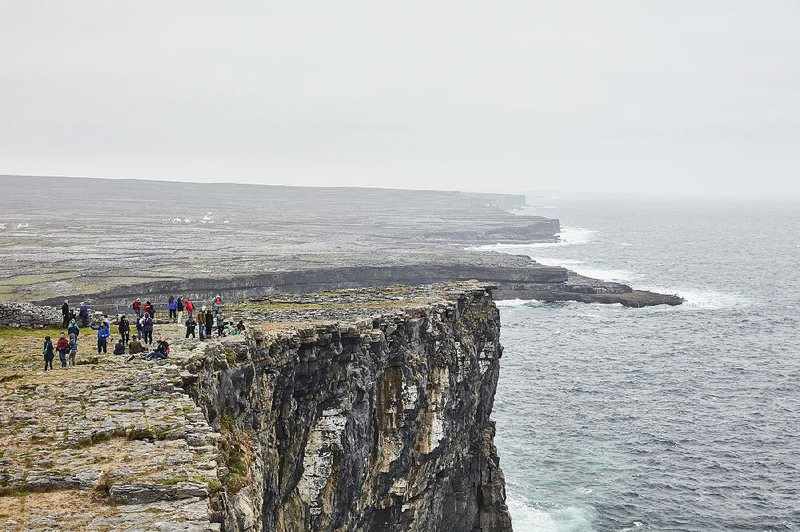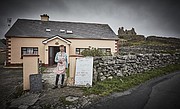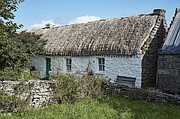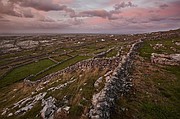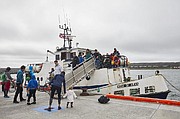The last time I saw Bridin Concannon, she was walking toward me along the narrow road on the westernmost edge of the island of Inishmaan, off the west coast of Ireland.
"Were you out at Synge's Chair?" I called out as she approached.
The sun behind her hung, unmasked by clouds, low and long in the Irish early summer sky.
"I was," she said. Her voice was strong, clear -- the way one's voice can be when exhilarated. "I'll start writing a play soon."
We both laughed loudly, and strode past one another. She was headed back toward the village and I toward the cliffs over the North Atlantic, to a perch of limestone that the author frequented during his time here, a spot known locally as Synge's Chair.
The Irish playwright J.M. Synge (1871-1909) first came to the Aran Islands in the summer of 1898 looking for inspiration and to learn the Irish language. Over the next several years he would return again and again, growing more connected to the people and the wind-and-sea-battered land they inhabited.
The foremost playwright of the Irish Renaissance -- a movement inspired by strong political nationalism and a revival of Celtic traditions -- Synge was co-founder of the Abbey, also known as the National Theatre of Ireland. All six of his plays are either set in or heavily influenced by his time in Aran.
The three remote Aran Islands of Inishmore, Inishmaan and Inisheer hide in plain sight in the mouth of Galway Bay. They are still predominantly Irish-speaking, insular and, as even in Synge's era, considered a place lost in time.
It was the poet William Butler Yeats who suggested that Synge come to these islands. "Go to Aran," Yeats told his friend. "Live there as if you were one of the people themselves; express a life that has never found expression."
Synge grew more attached to the islands over time, and I had a notion that repeat trips might similarly enhance my appreciation of Aran's more subtle charms. I decided to visit the islands over a several-months' period, from early spring to high summer.
Synge took a steamer from Galway that sailed at the mercy of the tides, on the rolling sea, and transferred into a currach, a small canvas-covered fishing boat, to make it to shore. These days things are slightly easier, with a daily ferry schedule as well as light aircraft service.
My initial impression of the largest island of Inishmore from the ferry was not dissimilar to Synge's. "A dreary rock appeared at first sloping up from the sea and into the fog," the author wrote in The Aran Islands, his classic account of his time here, first published in 1907. "The place looked hardly fit for habitation. There was no green to be seen, and no sign of the people ..."
Part of the considerable allure of Aran lies in what it lacks. There are no movie theaters and few cars; electricity only arrived in the 1970s. Seventeen-year-old Thomas Kennedy summed it up for me within minutes of my arrival when he said, "There's no facilities here; you rely on the people." And while much has remained unchanged since Synge's time, society has reached the islands. Synge wasn't confronted with the dozen or so glamping structures visible on arrival, for one. And the pier-side Atlantic Hotel, where Synge resided while on Inishmore, has been transformed into the Aran Sweater Market.
But beside the shop, three pubs, one food shop, a restaurant and a handful of bed-and-breakfasts, there is little else in the way of commerce. The 12-square-mile island is home to roughly 760 people, most clustered around the main settlement of Kilronan, with the vast majority of terrain given over to small parcels of grazing and farmland, delineated by Aran's most dominant feature, its dry-stone walls.
"You have to be OK within yourself to live here," Melissa Gillian told me as I stood eavesdropping on a wedding reception outside the Aran Island Hotel. A Maine native, she married a local man and has lived on Inishmore for 10 years. Gillian was one of only a handful of outsiders I met over the months, all are married to locals; her sentiment was one I heard often, on all three islands.
Most visitors stay only a few hours, travel a well-worn circuit and hustle back onto the boats for the comparative metropolis of Galway or the pubs of Doolin. But it is during the early morning hours, and again later in the afternoon once the last ferry of the day has gone, that the island's deeper appeal emerges.
If you've seen one image of the Aran Islands, it is likely to be an aerial shot of Inishmore's Dun Aengus, semicircular stone walls that abut a 300-foot sheer cliff above the Atlantic. The initial walls of this ring fort -- one of seven to be found on the islands -- date to 1100 B.C., and it is next to impossible not to gravitate to the site while on Inishmore. A visit at daybreak was rewarded by absolute solitude as the wind whistled over the stones. Birds caught thermals below the cliffs. Clouds raced across the sun. Time stretched.
Back in town the crowds were converging for the afternoon ferry to the mainland. On impulse, I grabbed my bag, deciding again to follow Synge's lead -- this time to another of the islands.
After only a brief stay on Inishmore, the playwright headed for Inishmaan, of which he noted, "Gaelic is more generally used, and the life is perhaps the most primitive that is left in Europe."
I wondered how much things had changed, and as I headed to the ferry for the short crossing to the middle island, Loraine Conneely, an Inishmore native, read my mind. "You'll see," she said. "It's still the same over there. It hasn't moved."
If the traveler is greeted with a (relatively) bustling arrival on the big island, no such welcome -- in fact, no welcome at all -- awaits the visitor to Inishmaan, which is less than four square miles. The ferry dock is a half-hour walk to what passes for a village (there is one shop and one bar). Life, as it did in Synge's time, revolves around the caprices of weather and the ties of community.
Little energy is spent looking outward -- exactly how the 160 inhabitants prefer things.
"We're ambivalent about tourists on this island," the restaurateur Ruairi de Blacam told me. "You're left to go about your business. Get a map -- you've got shoes -- and off you go." De Blacam is a local boy who made (extremely) good. In 2007 he and his wife, Marie-Therese, opened Inis Meain, the singular high-end restaurant and inn on the islands.
"It's unlikely, if not impossible, we could have done this if I wasn't from the island," he said as I sipped some of his delicious lobster bisque and watched a setting fireball sun slash light across the limestone just outside the restaurant's picture window. "You need the people's support.
"What you have to understand is that the people here live a very simple life. And we're here by choice. There's an understated pride, and the legacy of Synge is certainly a part of that."
Very much so: The cottage to which the playwright returned each year -- a small, whitewashed, thatch-roof affair -- has been preserved as a museum of sorts. Though it's technically open to the public, hours vary, and it took some doing to track down Ciaran O'Faherty, whose great-grandparents had offered Synge a bedroom in what was then their home. Once I finally cornered him in the pub, O'Faherty was happy to oblige me with a look. On this island that insists on existing out of time, the cottage's green front door was a portal through the century; things inside remain as Synge had described: "My room is at one end of the cottage ... there is a kitchen with earth floor and open rafters ... it is full of beauty and distinction."
With just the one pub for action, nights on Inishmaan are quiet and even a loner can yearn for society. As Synge did, I made the short crossing to the smallest island of Inisheer (on two occasions I was the only ferry passenger from Inishmaan).
As on Inishmore, the day tourist trade had taken hold. There were horse and trap rides, coffee carts and stands selling local fudge. But just beyond the flurry of town, Inisheer, with its 250 residents, is perhaps the most physically picturesque of the three Aran Islands, and its three square miles make it easy to navigate on bicycle. (Bikes were readily available directly off the ferry on Inishmore and Inisheer. Not surprisingly, there was no bike rental on Inishmaan.)
Atop the island's highest hill, beside the ruin of O'Brien's Castle, Aine O'Graiofa had put a few tables out in front of her home and called it a restaurant. I took a seat in the driveway and settled in for one of Ireland's staple country lunches -- ham and cheese on toasted white bread -- while looking down across Galway Bay to Connemara in the distance.
Inisheer boasts three pubs, one shop and a single church.
"The priest died four years ago and they haven't sent another," O'Graiofa told me. "We're left to our own devices."
Back on Inishmaan I walked past the old graveyard from which Synge took inspiration for his play Riders to the Sea and continued up the hill, across from Synge's cottage and up over five stone fences and through five small fields to the ring fort of Dun Chonchuir.
Like Synge, I had sat on these walls and viewed the sea in nearly every direction, but on this evening, a fog rolled in. The air became moist. Summer changed to autumn in a matter of minutes. I could barely make out the far end of the small fort enclosure. With no wind, a heavy silence hung in the mist. The century that separated me from Synge seemed suddenly trivial, and a world beyond these dry stone walls didn't matter at all.
Travel on 09/30/2018

